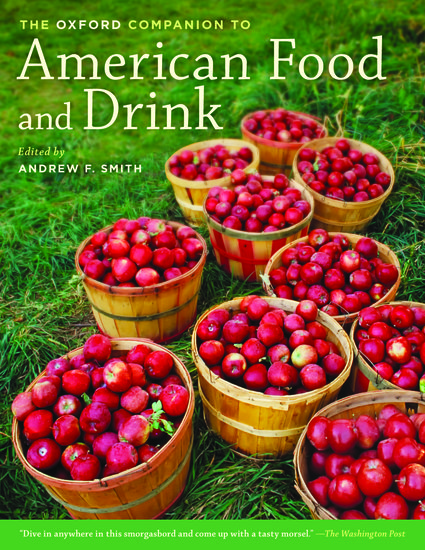One hundred years ago today, a legendary and influential American chef was born: Julia Child. With the introduction of fine food into every American home with books and television appearances, her unpretentious and enthusiastic attitude welcomed many to the art of cooking. We’re celebrating Julia Child’s life and work with an extract by Lynne Sampson from The Oxford Companion to American Food and Drink.
Julia Child (1912–2004) became the most celebrated American cook and an important cultural figure in a public career spanning more than forty years. Her appealing blend of education and entertainment in the groundbreaking television series The French Chef introduced classical cooking techniques, exotic ingredients, and specialty equipment to mainstream America in the 1960s and 1970s. As a popular television personality, cookbook author, and mentor, Child elevated the status of cooking, shaped modern notions of food, and contributed to the development of the culinary profession throughout the second half of the twentieth century.
Child’s success as a media star was often attributed to her charming wit and uninhibited nature. The oldest daughter of a well-to-do family, Julia McWilliams was born in Pasadena, California, and graduated from Smith College in Northampton, Massachusetts, in 1934. A position with the Office of Strategic Services during World War II took her to posts in Asia, where she met her husband, Paul Child, who later became her collaborator. Her culinary career began at the age of thirty-seven, when the Childs moved to Paris and she enrolled in the Cordon Bleu cooking school.
Child’s first cookbook, Mastering the Art of French Cooking, was the product of her collaboration with two Frenchwomen, Simone Beck and Louisette Bertholle. The three were partners in a Paris cooking school called L’Ecole des Trois Gourmandes, and its insignia decorated the blouse Child later wore on The French Chef. The book’s long route to publication is part of publishing lore. Ten years in the making and rejected by Houghton Mifflin, its contracted publisher, Mastering the Art of French Cooking was ultimately published by Knopf in 1961 to great acclaim. The best-selling cookbook was the first to popularize the principles of French cooking to a broad-based American audience. Thorough instructions and consideration of available ingredients set a new standard in cookbook writing, a model for the many cookbooks on ethnic cuisines that followed in the 1970s.
Child achieved her greatest influence through television. Although it was initially broadcast on a Boston public television station, The French Chef quickly became a national sensation, watched by men and women, noncooks and cooks, and won the first of its five Emmy Awards in 1965, a landmark event for educational television. Its popularity was due in part to Child’s sense of humor and the mistakes she handled with aplomb. Statuesque, with an unmistakable warbling voice, her manner and gaffes were frequently exaggerated and widely parodied. The French Chef, which aired from 1963 to 1973, created the celebrity called ‘‘Julia’’ and institutionalized the televised cooking show.
Her role as an educator was paramount to the show’s success and popularity. She approached haute cuisine with a sense of fun and fearlessness and emphasized simplicity over snobbery. Although she strayed from French cooking in successive series, she remained devoted to teaching home cooks the pleasures of preparing a meal—and to public television. She was also instrumental in the development of the American Institute of Wine and Food and the International Association of Culinary Professionals. She became a mentor to many chefs and was a role model for women in the field.
Soon after receiving the French Legion of Honor and just before her ninetieth birthday, Child left her home in Cambridge, Massachusetts, and the famous kitchen that was the set for her last three cooking shows to return to southern California. In recognition of her role in American social history, the Smithsonian Institution acquired her original kitchen with nearly all of its contents, including the pegboard wall of pans and the Garland stove, and reinstalled it in the National Museum of American History in 2002.
Bibliography
Beck, Simone, Louisette Bertholle, and Julia Child. Mastering the Art of French Cooking. New York: Knopf, 1961.
Fitch, Noël Riley. Appetite for Life: The Biography of Julia Child. New York: Doubleday, 1997.
Greenspan, Dorie. Baking with Julia. New York: Morrow, 1996.
A sweeping reference work on food and drink in America, with fascinating entries on everything from the history of White Castle to the origin of the Bloody Mary, The Oxford Companion to American Food and Drink provides more than a thousand concise, authoritative, and exuberant entries, beautifully illustrated with hundreds of historical photographs and sixteen pages of color plates. Editor Andrew F. Smith teaches culinary history and professional food writing at The New School University in Manhattan. He serves as a consultant to several food television productions (airing on the History Channel and the Food Network), and is the General Editor for the University of Illinois Press’ Food Series. He also edited the highly acclaimed 2-volume Encyclopedia of Food and Drink in America and has written several books on food, including The Tomato in America, Pure Ketchup, and Popped Culture: A Social History of Popcorn in America.
Subscribe to the OUPblog via email or RSS.
Subscribe to only articles about food and drink on the OUPblog via email or RSS.
View more about this book on the ![]()
![]()




Recent Comments
There are currently no comments.